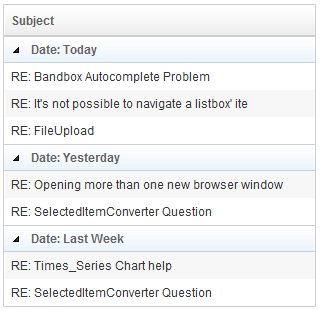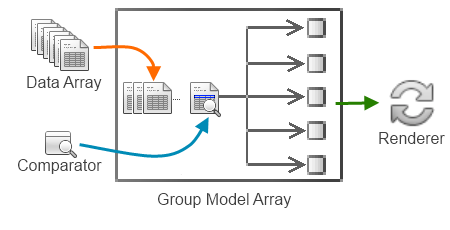Groups Model"
m |
m |
||
| Line 6: | Line 6: | ||
Instead of implementing <javadoc type="interface">org.zkoss.zul.GroupsModel</javadoc>, it is suggested to extend from <javadoc>org.zkoss.zul.AbstractGroupsModel</javadoc>, or to use one of the default implementations: <javadoc>org.zkoss.zul.GroupsModelArray</javadoc> and <javadoc>org.zkoss.zul.SimpleGroupsModel</javadoc>. <javadoc>org.zkoss.zul.GroupsModelArray</javadoc> supports regrouping, while <javadoc>org.zkoss.zul.SimpleGroupsModel</javadoc> is simpler but no regrouping is allowed (i.e., immutable). | Instead of implementing <javadoc type="interface">org.zkoss.zul.GroupsModel</javadoc>, it is suggested to extend from <javadoc>org.zkoss.zul.AbstractGroupsModel</javadoc>, or to use one of the default implementations: <javadoc>org.zkoss.zul.GroupsModelArray</javadoc> and <javadoc>org.zkoss.zul.SimpleGroupsModel</javadoc>. <javadoc>org.zkoss.zul.GroupsModelArray</javadoc> supports regrouping, while <javadoc>org.zkoss.zul.SimpleGroupsModel</javadoc> is simpler but no regrouping is allowed (i.e., immutable). | ||
| − | |||
| − | |||
For example, suppose you have a two-dimensional array, then you could | For example, suppose you have a two-dimensional array, then you could | ||
| Line 41: | Line 39: | ||
</zk> | </zk> | ||
</source> | </source> | ||
| + | |||
| + | Then, the result | ||
| + | |||
| + | [[Image:DrGroupsModel.png]] | ||
=Sorting and Regrouping= | =Sorting and Regrouping= | ||
| + | |||
| + | [[Image:Grouping_model_explain.png]] | ||
| + | |||
| + | =Group Footer = | ||
=Version History= | =Version History= | ||
Revision as of 08:25, 30 December 2010
Here we describe how to implement a groups model (GroupsModel). For the concept about component, model and render, please refer to the Model-driven Display section.
A groups model is used to drive components that support groups of data. The groups of data is a two dimensional data: a list of grouped data and each grouped data is a list of data to display. Here is an example. Currently, Listbox and Grid both support a list of grouped data.
Instead of implementing GroupsModel, it is suggested to extend from AbstractGroupsModel, or to use one of the default implementations: GroupsModelArray and SimpleGroupsModel. GroupsModelArray supports regrouping, while SimpleGroupsModel is simpler but no regrouping is allowed (i.e., immutable).
For example, suppose you have a two-dimensional array, then you could
<zk>
<zscript>
String[][] datas = new String[][] {
new String[] {
// Today
"RE: Bandbox Autocomplete Problem",
"RE: It's not possible to navigate a listbox' ite",
"RE: FileUpload"
},
new String[] {
// Yesterday
"RE: Opening more than one new browser window",
"RE: SelectedItemConverter Question"
},
new String[] {
"RE: Times_Series Chart help",
"RE: SelectedItemConverter Question"
}
};
GroupsModel model = new SimpleGroupsModel(datas,
new String[]{"Date: Today", "Date: Yesterday", "Date: Last Week"});
</zscript>
<grid model="${model}">
<columns sizable="true">
<column label="Subject"/>
</columns>
</grid>
</zk>
Then, the result
Sorting and Regrouping
Version History
| Version | Date | Content |
|---|---|---|

